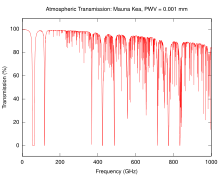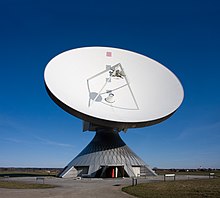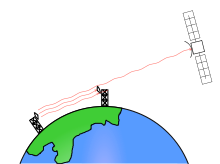Microwave transmission

Microwave transmission is the
Although an experimental 40-mile (64 km) microwave
In the post-war era, the development of microwave technology was rapid, which led to the construction of several transcontinental microwave relay systems in North America and Europe. In addition to carrying thousands of telephone calls at a time, these networks were also used to send television signals for cross-country broadcast, and later, computer data.
In recent years, there has been an explosive increase in use of the microwave spectrum by new telecommunication technologies such as
Uses
Microwaves are widely used for

Microwave radio transmission is commonly used in
The next higher frequency band of the
- Wireless transmission of information
- One-way and two-way telecommunication using communications satellite
- Terrestrial microwave relay links in telecommunications networks including backbone or backhaul carriers in cellular networks
More recently, microwaves have been used for
Microwave radio relay
Microwave radio relay is a technology widely used in the 1950s and 1960s for transmitting information, such as long-distance
Beginning in the 1950s, networks of microwave relay links, such as the
Planning

Because in microwave transmission the waves travel in narrow beams confined to a line-of-sight path from one antenna to the other, they do not interfere with other microwave equipment, so nearby microwave links can use the same frequencies. The antennas must therefore be highly

Because of the high frequencies used, a line-of-sight path between the stations is required. Additionally, in order to avoid attenuation of the beam, an area around the beam called the first Fresnel zone must be free from obstacles. Obstacles in the signal field cause unwanted attenuation. High mountain peaks or ridges are often ideal positions for the antennas.
In addition to the use of conventional repeaters with back-to-back radios transmitting on different frequencies, obstructions in microwave paths can also be dealt with by using Passive repeater or on-frequency repeaters.
Obstacles, the curvature of the Earth, the geography of the area and reception issues arising from the use of nearby land (such as in manufacturing and forestry) are important issues to consider when planning radio links. In the planning process, it is essential that "path profiles" are produced, which provide information about the terrain and Fresnel zones affecting the transmission path. The presence of a water surface, such as a lake or river, along the path also must be taken into consideration since it can reflect the beam, and the direct and reflected beam can interfere with each other at the receiving antenna, causing
The effects of atmospheric stratification cause the radio path to bend downward in a typical situation so a major distance is possible as the earth equivalent curvature increases from 6,370 km (3,960 mi) to about 8,500 km (5,300 mi) (a 4/3 equivalent radius effect). Rare events of temperature, humidity and pressure profile versus height, may produce large deviations and distortion of the propagation and affect transmission quality. High-intensity rain and snow making rain fade must also be considered as an impairment factor, especially at frequencies above 10 GHz. All of the detrimental factors mentioned in this section, collectively known as path loss, make it necessary to compute suitable power margins, in order to maintain the link operative for a high percentage of time, like the standard 99.99% or 99.999% used in 'carrier class' services of most telecommunication operators.
The longest known microwave radio relay crosses the Red Sea with a 360 km (220 mi) hop between Jebel Erba (2,170 m (7,120 ft) a.s.l., 20°44′46.17″N 36°50′24.65″E / 20.7461583°N 36.8401806°E, Sudan) and Jebel Dakka (2,572 m (8,438 ft) a.s.l., 21°5′36.89″N 40°17′29.80″E / 21.0935806°N 40.2916111°E, Saudi Arabia). The link was built in 1979 by Telettra to transmit 300 telephone channels and one TV signal, in the 2 GHz frequency band. (Hop distance is the distance between two microwave stations).[2][unreliable source?]
Previous considerations represent typical problems characterizing terrestrial radio links using microwaves for the so-called backbone networks: hop lengths of a few tens of kilometers (typically 10 to 60 km (6.2 to 37.3 mi)) were largely used until the 1990s. Frequency bands below 10 GHz, and above all, the information to be transmitted, were a stream containing a fixed capacity block. The target was to supply the requested availability for the whole block (
The emitted power is regulated for cellular and microwave systems. These microwave transmissions use emitted power typically from 0.03 to 0.30 W, radiated by a parabolic antenna on a narrow beam diverging by a few degrees (1 to 3-4). The microwave channel arrangement is regulated by International Telecommunication Union (
History

The history of radio relay communication began in 1898 with the publication by Johann Mattausch in the Austrian journal, Zeitschrift für Elektrotechnik.[3][4] But his proposal was primitive and not suitable for practical use. The first experiments with radio repeater stations to relay radio signals were done in 1899 by Emile Guarini-Foresio.[3] However the low frequency and medium frequency radio waves used during the first 40 years of radio proved to be able to travel long distances by ground wave and skywave propagation.[citation needed]
In 1931, an Anglo-French consortium headed by Andre C. Clavier demonstrated an experimental microwave relay link across the English Channel using 10-foot (3 m) dishes.[5] Telephony, telegraph, and facsimile data was transmitted over the bidirectional 1.7 GHz beams 40 miles (64 km) between Dover, UK, and Calais, France. The radiated power, produced by a miniature Barkhausen–Kurz tube located at the dish's focus, was one-half watt. A 1933 military microwave link between airports at St. Inglevert, France, and Lympne, UK, a distance of 56 km (35 miles), was followed in 1935 by a 300 MHz telecommunication link, the first commercial microwave relay system.[6]
The development of radar during World War II provided much of the microwave technology which made practical microwave communication links possible, particularly the klystron oscillator and techniques of designing parabolic antennas. Though not commonly known, the British Army used the Wireless Set Number 10 in this role during World War II.[citation needed] The need for radio relay did not really begin until the 1940s exploitation of microwaves, which traveled by line of sight and so were limited to a propagation distance of about 40 miles (64 km) by the visual horizon.[citation needed]
After the war, telephone companies used this technology to build large microwave radio relay networks to carry long-distance telephone calls. During the 1950s a unit of the US telephone carrier,

Remarkable were the microwave relay links to West Berlin during the Cold War, which had to be built and operated due to the large distance between West Germany and Berlin at the edge of the technical feasibility. In addition to the telephone network, also microwave relay links for the distribution of TV and radio broadcasts. This included connections from the studios to the broadcasting systems distributed across the country, as well as between the radio stations, for example for program exchange.[citation needed]
Military microwave relay systems continued to be used into the 1960s, when many of these systems were supplanted with
Long-distance microwave relay networks were built in many countries until the 1980s, when the technology lost its share of fixed operation to newer technologies such as

During the Cold War, the US intelligence agencies, such as the National Security Agency (NSA), were reportedly able to intercept Soviet microwave traffic using satellites such as Rhyolite/Aquacade.[8] Much of the beam of a microwave link passes the receiving antenna and radiates toward the horizon, into space.[citation needed] By positioning a geosynchronous satellite in the path of the beam, the microwave beam can be received.
At the turn of the century,[
Microwave link
A microwave link is a communications system that uses a beam of radio waves in the microwave frequency range to transmit
Mobile units can be camera mounted, allowing cameras the freedom to move around without trailing cables. These are often seen on the touchlines of sports fields on Steadicam systems.
Properties of microwave links
- Involve line of sight (LOS) communication technology
- Affected greatly by environmental constraints, including rain fade
- Have very limited penetration capabilities through obstacles such as hills, buildings and trees
- Sensitive to high pollen count[citation needed]
- Signals can be degraded during Solar proton events[9]
- Propagation delays are lower than in fiber optic networks because the speed of light in air is faster than in optical cable[10]
Uses of microwave links
- In communications between satellitesand base stations
- As backbone carriers for cellular systems
- In short-range indoor communications
- Linking remote and regional telephone exchanges to larger (main) exchanges without the need for copper/optical fibre lines
- Measuring the intensity of rain between two locations
- To give financial advantage to high frequency traders at one stock exchange via faster knowledge of price changes at a distant exchange[10]
Troposcatter
Terrestrial microwave relay links are limited in distance to the visual horizon, a few tens of miles or kilometers depending on tower height. Tropospheric scatter ("troposcatter" or "scatter") was a technology developed in the 1950s to allow microwave communication links beyond the horizon, to a range of several hundred kilometers. The transmitter radiates a beam of microwaves into the sky, at a shallow angle above the horizon toward the receiver. As the beam passes through the troposphere a small fraction of the microwave energy is scattered back toward the ground by water vapor and dust in the air. A sensitive receiver beyond the horizon picks up this reflected signal. Signal clarity obtained by this method depends on the weather and other factors, and as a result, a high level of technical difficulty is involved in the creation of a reliable over horizon radio relay link. Troposcatter links are therefore only used in special circumstances where satellites and other long-distance communication channels cannot be relied on, such as in military communications.
See also
References
- ^ ISBN 9-780-9816-9230-2.
- ^ Umberto Casiraghi (May 21, 2010). "A vintage document: Reference Radio Link Telettra on the Red Sea, 360km and world record". Telettra. Retrieved 2012-10-02 – via Facebook.
- ^ a b Slyusar, Vadym. (2015). First Antennas for Relay Stations (PDF). International Conference on Antenna Theory and Techniques, 21–24 April 2015, Kharkiv, Ukraine. pp. 254–255.
- ^ Mattausch, J. (16 January 1898). "Telegraphie ohne Draht. Eine Studie" [Telegraph without wire. A study] (PDF). Zeitschrift für Elektrotechnik (in German). XVI (3). Elektrotechnischen Vereines in Wien: 35–36 – via www.slyusar.kiev.ua.
- ^ Free, E.E. (August 1931). "Searchlight radio with the new 7 inch waves" (PDF). Radio News. Vol. 8, no. 2. New York: Radio Science Publications. pp. 107–109. Retrieved March 24, 2015.
- ^ "Microwaves span the English Channel" (PDF). Short Wave Craft. Vol. 6, no. 5. New York: Popular Book Co. September 1935. pp. 262, 310. Retrieved March 24, 2015.
- ^ "Sugar Scoop Antennas Capture Microwaves". Popular Mechanics. Hearst Magazines. February 1985. p. 87.
- ISBN 978-0-385-52132-1.
- ^ Kincaid, Cheryl-Annette (May 2007). Analyzing Microwave Spectra Collected by the Solar Radio Burst Locator (MSc). Denton, Texas: University of North Texas. Retrieved 2012-10-02 – via UNT Digital Library.
- ^ ISSN 0732-8516.
- Microwave Radio Transmission Design Guide, Trevor Manning, Artech House, 1999
External links
- RF / Microwave Design at Oxford University
- AT&T's Microwave Radio-Relay Skyway introduced in 1951
- Bell System 1951 magazine ad for Microwave Radio-Relay systems.
- RCA vintage magazine ad for Microwave-Radio Relay equipment used for Western Union Telegraph Co.
- AT&T Long Lines Microwave Towers Remembered
- AT&T Long Lines
- IEEE Global History Network Microwave Link Networks

